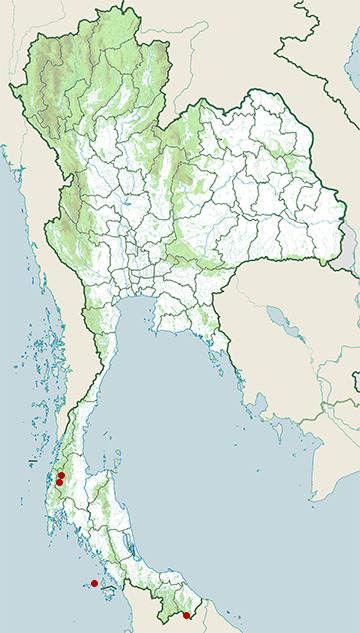Species of Thailand
Greater mouse-deer
Tragulus napu
(Georges-Frédéric Cuvier, 1822)
In Thai: กระจงควาย
The greater mouse-deer, greater Malay chevrotain, or napu (Tragulus napu) is a species of even-toed ungulate in the family Tragulidae found in Sumatra, Borneo, and smaller Malaysian and Indonesian islands, and in southern Myanmar, southern Thailand, and peninsular Malaysia. Its natural habitat is subtropical or tropical, moist, lowland forest.
Etymology
Tragos is Greek for "goat" and –ulus in Latin means "tiny". Napu is a local name, from Malay napuh. The name "mouse-deer" refers to its small size and does not imply that it is a true deer. It is called "greater" because it is larger than other Tragulus species.
Morphology
The greater mouse-deer is an even-toed ungulate. Although very small for an ungulate, the greater mouse-deer is one of the largest members of its genus. It is rivalled in size by Williamson's mouse-deer. It weighs 5 to 8 kg. Its head-and-body length is 70 to 75 cm and its tail length is 8 to 10 cm. Its shoulder height is about 30 to 35 cm It has a small, triangular head with a small, pointed, black nose and large eyes. Its long legs are as thin as a pencil. The hind legs are visibly longer than the front legs. The body is rounded. The fur on the upper part of its body is grey-buff to orange-buff. On the sides, the fur is quite pale, but darker along the midline. It is white underneath, more specifically on the neck, stomach, chest, and chin. The male has neither horns nor antlers, but has small "tusks" – elongated canines in the upper jaws.
Distribution
Greater mouse-deer are found in Sumatra, Borneo, and smaller Malaysian and Indonesian islands, and in southern Myanmar, southern Thailand, and peninsular Malaysia. They live near water, in tropical forests and mangrove thickets. Thought to be regionally extinct in Singapore, they were rediscovered on an offshore island in 2008. Reports of its occurrence elsewhere are probably incorrect. They are terrestrial, but spend time in wet, swampy areas.
Behaviour
The greater mouse-deer is solitary and nocturnal. It uses small trails through thick brush in the forest. When the male is ready to mate, he rubs a large gland on his lower jaw against the female to determine whether she is ready to mate. If she is not ready, she responds by walking away. The male is very territorial, marking his territory with feces, urine, and secretions from the intermandibular gland under the chin. When angry, the male beats the ground with his hooves at a rate of four times per second.
They are rather trusting but delicate animals. They feed on fallen fruits, aquatic plants, buds, leaves, shrubs and grasses.
Reproduction
Greater mouse-deer breed throughout the year; the female spends most of her adult life pregnant. They usually produce one young per birth, after a gestation of 152–155 days. Newborn animals are well-developed and immediately able to stand; they are fully active after 30 minutes. The young stand on three legs while nursing. Both male and female become mature at age 4½ months. Their lifespan is up to 14 years.
Conservation status
The major threats to T. napu are overhunting by humans and loss of habitat through rapid deforestation.
This article uses material from Wikipedia released under the Creative Commons Attribution-Share-Alike Licence 3.0. Eventual photos shown in this page may or may not be from Wikipedia, please see the license details for photos in photo by-lines.
Scientific classification
- Kingdom
- Animalia
- Phylum
- Chordata
- Class
- Mammalia
- Subclass
- Theria
- Order
- Artiodactyla
- Family
- Tragulidae
- Genus
- Tragulus
- Species
- Tragulus napu
Common names
- German: Großkantschil
- English:
- Balabac chevrotain
- Greater Indo-Malayan chevrotain
- Greater mouse-deer
- Greater Oriental chevrotain
- Larger Malay chevrotain
- Larger mouse-deer
- Napu
- Spanish: Ciervo ratón grande
- French:
- Chevrotain napu
- Grand tragul malais
- Italian:
- Tragulo maggiore
- Tragulo della Malesia maggiore
- Dutch: Grote kantjil
- Russian:
- Большой оленёк
- оленёк напу
- большой канчиль
- Swedish: Större mushjort
- Thai: กระจงควาย
Synonyms
- Moschus napu, Georges-Frédéric Cuvier (1822)
Conservation status

Least Concern (IUCN3.1)
Photos

Range Map

- Hala-Bala Wildlife Sanctuary
- Khao Sok National Park
- Khlong Saeng Wildlife Sanctuary
- Tarutao National Marine Park